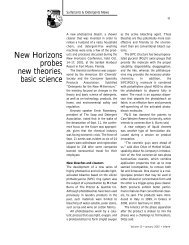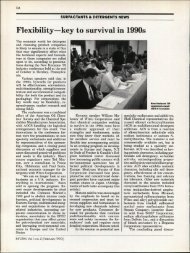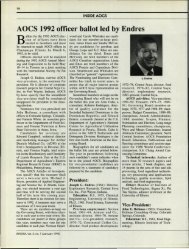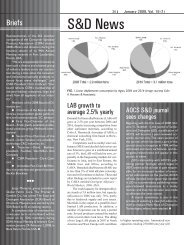087AP03 GlobalMarket p162-163 - staging.files.cms.plus.com
087AP03 GlobalMarket p162-163 - staging.files.cms.plus.com
087AP03 GlobalMarket p162-163 - staging.files.cms.plus.com
You also want an ePaper? Increase the reach of your titles
YUMPU automatically turns print PDFs into web optimized ePapers that Google loves.
162 COVER FEATURE inform • April 2003 • Volume 14 (4)<br />
It’s a global market out there<br />
Barbara Jewett<br />
There is little doubt that more and more business<br />
is being conducted on a global level.<br />
Agricultural products have been traded<br />
around the world for decades. But now, logos<br />
from multinational corporations are recognized<br />
around the globe—from soft drinks<br />
and hamburgers to running shoes, hotel chains,<br />
and detergents. It is <strong>com</strong>monplace for products<br />
to have <strong>com</strong>ponents manufactured in<br />
one country and be assembled in another. In<br />
fact, you probably use globalization’s greatest<br />
product every day: the Internet.<br />
Global focus<br />
The concept of global brands is increasingly<br />
<strong>com</strong>mon in today’s business climate<br />
as corporations, particularly the large multinationals,<br />
focus on reducing product ranges,<br />
streamlining manufacturing operations,<br />
and maintaining or increasing market share.<br />
“There are advantages of global brands,”<br />
explained William Lesch, professor of international<br />
marketing at the University of<br />
North Dakota in Grand Forks. “Corporations<br />
can take advantage of the economies of<br />
scale in production, distribution, and advertising,<br />
which can ultimately save them millions<br />
of dollars.”<br />
Globalization of a brand is not, however,<br />
as easy as one might think, cautioned<br />
Lesch. “There are many factors which need<br />
to be considered when introducing a brand<br />
across country lines,” he said. “Are there<br />
legal hurdles to over<strong>com</strong>e? For instance,<br />
at one time Italy had a short list of approved<br />
sweeteners and your product had to use one<br />
of the ones on their list or you couldn’t sell<br />
it in Italy. Another factor to consider: Is the<br />
product of such a nature that it will be<br />
received differently in different countries?<br />
Are the country factors in place to allow<br />
the product/brand to transfer, or does the<br />
product need to be adapted?”<br />
An example, said Lesch, would be<br />
soap. A soap and detergent manufacturer<br />
considering expansion to a new world market<br />
needs to consider water quality and<br />
whether the product, as formulated, will<br />
deliver the promised results when used in<br />
the water in the new market area. In addition,<br />
noted Lesch, potable water in many<br />
countries is available only a few hours a<br />
day, which would affect marketing strategies.<br />
Multinationals expand<br />
According to the United Kingdom’s<br />
Leatherhead Food International (netlink:<br />
www.leatherheadfood.<strong>com</strong>), mergers and<br />
acquisitions have occurred in most of the<br />
regions of the world, although the major<br />
deals have involved corporations based in<br />
Europe or the United States. Sectors such<br />
as bakery products, dairy products, confectionery,<br />
pet foods, and beer saw significant<br />
acquisition activity the past two years,<br />
they noted.<br />
The most <strong>com</strong>mon reasons for acquisitions,<br />
said Leatherhead, are to enter new markets<br />
or territories, extend the range of products<br />
or brands, achieve economies of scale, add<br />
to internal capabilities, such as research and<br />
development or distribution, or counter<br />
increased buying power by retailers.<br />
Although acquisitions are <strong>com</strong>mon<br />
among small- and medium-sized <strong>com</strong>panies,<br />
in recent years the world has seen<br />
an increasing number of acquisitions among<br />
large corporations. Acquisitions of large<br />
food and drink manufacturers by <strong>com</strong>panies<br />
already in the world’s top 10, reports<br />
Leatherhead, resulted in sales increases of<br />
nearly16% in two years. The largest acquisition,<br />
noted Leatherhead in their January<br />
2003 edition of food news, was Unilever’s<br />
(Rotterdam, The Netherlands) $21.3 billion<br />
purchase of Bestfoods in 2000, followed<br />
by Kraft Foods’ (Northfield, Illinois)<br />
$19.2 billion payout for Nabisco that same<br />
year.<br />
The global food industry has seen a<br />
slowdown in merger activity following the<br />
megadeals of 2000, said Leatherhead, but<br />
they predict merger and acquisition activity<br />
will rise as the economic situation<br />
improves. “The trend towards consolidation<br />
will create increasingly powerful multinationals<br />
with a portfolio of strong brands,”<br />
they noted.<br />
World-class brands<br />
The University of Texas at Brownsville<br />
(UTB) has an ongoing study of global branding,<br />
said Betsy V. Boze, dean of the School<br />
of Business. The study, originated by Charles<br />
R. Patton (who has since retired from UTB<br />
and is now a professor emeritus), focuses<br />
on the “big three” soapmakers—Procter &<br />
Gamble (P&G), Cincinnati, Ohio; Colgate-<br />
Palmolive, New York, New York; and<br />
Unilever—and is updated every few years.<br />
Although the emphasis is on the corporation’s<br />
household cleaner and fabric care<br />
brands, the study also explores toilet soap<br />
and toothpaste; other products the <strong>com</strong>panies<br />
manufacture are not included in the<br />
study.<br />
Field research began in the mid-1990s<br />
and has been <strong>com</strong>pleted in 135 countries,<br />
said Boze. Early research identified 263<br />
brands of soap and detergent. Surprisingly,<br />
in using the parameter established by UTB<br />
researchers that the brand must be distributed<br />
in 20 or more countries to be considered<br />
a global brand, only 22 of the hundreds<br />
of brands identified were classified as global.<br />
They were: Ajax, Dynamo, Fab, and<br />
Palmolive, all manufactured by Colgate-<br />
Palmolive; Ariel, Bounce, Cascade, Comet,<br />
Downy, Joy, Mr. Clean (also known as<br />
Maestro Limpio, Maestro Lindo, Meister<br />
Proper, M. Net, and M. Propre in different<br />
nations), Spic & Span, and Tide from P&G;<br />
and Comfort, Jif, Omo, Rinso, Snuggle,<br />
Sun, Sunlight, Surf, and Vim from Unilever.
inform • April 2003 • Volume 14 (4) COVER FEATURE <strong>163</strong><br />
(Note: Comet is retailed in North America<br />
by Prestige Brands; Spic & Span is retailed<br />
in North America by the Shansby Group,<br />
San Francisco, California.) Surprisingly,<br />
six of these brands—Ariel, Comfort, Jif,<br />
Omo, Sun, and Vim—are not sold in the<br />
United States, which is the world’s largest<br />
cleaning products market. (An exception<br />
to this statement, noted UTB researchers,<br />
is Ariel—a small quantity of Ariel is shipped<br />
from Mexico to United States border cities<br />
with a large Hispanic population.)<br />
Advertising the brands<br />
If a product crosses country lines, does the<br />
advertising follow suit?<br />
“Sometimes,” replied Marie McNeely,<br />
executive vice president, global equity<br />
director, for Saatchi & Saatchi, a worldwide<br />
advertising agency with offices in 82<br />
countries that is owned by Paris-based<br />
Publicis Group, S.A. McNeely is based<br />
in the agency’s New York office where she<br />
oversees the worldwide advertising for<br />
P&G’s fabric and home-care business.<br />
According to Advertising Age’s Special<br />
Report (November 11, 2002), P&G leads<br />
the media spending of global marketers,<br />
spending $3.82 billion in 2001. Unilever<br />
was third, spending slightly over $3 billion,<br />
and Colgate-Palmolive ranked 42nd,<br />
with expenditures of nearly $5.5 million.<br />
It should be noted that these spending totals<br />
reflect expenditures for all brands, not just<br />
household cleaners and fabric care.<br />
Most aspects of advertising and marketing<br />
are cross-cultural, said McNeely.<br />
For instance, the concept that consumers<br />
buy with their feelings, then later rationalize<br />
the purchase decision. Or, she said,<br />
the fact that the human mind makes narrative,<br />
designing causal links to form stories<br />
that create a plot-line of experience and<br />
then serve as a <strong>com</strong>parator to the next<br />
moment. These stories usually are based<br />
on emotion, not logic, explained McNeely.<br />
“Where marketers trip,” said McNeely,<br />
“is that they are very often confident about<br />
who they are, what they offer in each country<br />
around the world, but they often are less<br />
sure of the real wants, needs, and sensibilities<br />
of their consumers. The best marketing<br />
is based on building a long-term<br />
relationship, not next week’s transaction.<br />
And that means paying attention to whom<br />
you want to marry you, and understanding<br />
how you can show that person that you love<br />
and appreciate him or her.<br />
“When the topic of global/local marketing<br />
<strong>com</strong>es up,” she continued, “the<br />
process always gets the attention. Does one<br />
centralize and adapt locally or the other<br />
way ’round? What doesn’t get the attention<br />
and should, I think, is an understanding<br />
of the brand’s relationship with the<br />
consumer in a market, relative to its <strong>com</strong>petition<br />
and its history. If we looked at<br />
global marketing that way, chances are<br />
you’ll find your brand in a handful of relationship<br />
states [similar to interpersonal<br />
romantic relationships] with its consumers<br />
across markets—courting, happily married,<br />
married but straying, divorced.<br />
Advertising can be developed and reapplied<br />
based on the relationship state then,<br />
rather than the geography.”<br />
Global trends reshaping<br />
business strategies<br />
The World Business Council for Sustainable<br />
Development (WBCSD), headquartered in<br />
Geneva, Switzerland (netlink: www.<br />
wbcsd.org), is a coalition of chief executive<br />
officers from 160 international <strong>com</strong>panies<br />
(representing more than 30 countries and 20<br />
major industrial sectors) working together<br />
with the shared belief that the pursuit of sustainable<br />
development is good for business<br />
and business is good for sustainable development.<br />
Sustainable development, says<br />
the group, is about improving the quality of<br />
life for everyone, now and in the future.<br />
In their report “Sustainability Through<br />
the Market: Seven Keys to Success,” issued<br />
in April 2001 (netlink: www.wbcsd.org/news<br />
center/2001.htm), the group describes strategies<br />
to creating open markets that can benefit<br />
business by generating growth through<br />
innovation and new markets, while also utilizing<br />
cost efficiencies.<br />
Businesses that wish to survive and<br />
thrive in a global economy must respond<br />
to major social and environmental trends,<br />
according to an April 2002 report issued<br />
jointly by the United Nations Environmental<br />
Program, WBCSD, and the World Resources<br />
Institute. The report, entitled “Tomorrow’s<br />
Market: Global Trends and Their Implications<br />
for Business” (netlink: www.wbcsd.org/news<br />
center/2002.htm), focuses on the rising interest<br />
in using market solutions to address some<br />
of the world’s most pressing problems, such<br />
as severely degraded natural resources, ecosystems,<br />
health, education, population, energy,<br />
emissions, fresh water, urbanization, and<br />
many other issues.<br />
Globalization foes<br />
Although globalization has integrated the<br />
world technologically, economically, and<br />
politically and is credited with stimulat-<br />
ing innovation and technological progress,<br />
it is also blamed for increasing the gap<br />
between rich and poor, accelerating the<br />
destruction of the environment, and threatening<br />
human rights. This, according to<br />
Anthony J. Daboub, an assistant professor<br />
in the School of Business at UTB, and Jerry<br />
M. Calton, an associate professor in the<br />
School of Business at the University of<br />
Hawaii–Hilo, has resulted in intensely<br />
angry feelings of many people around the<br />
world, directed primarily at the multinational<br />
corporations.<br />
The issues involved in the antiglobalization<br />
movement are as <strong>com</strong>plex and<br />
varied as the actors in the drama, say<br />
Daboub and Calton, noting that antiglobalization<br />
demonstrators blame the major<br />
brands for a variety of ills ranging from<br />
child labor, low wages, and sweatshops to<br />
global warming, destruction of the natural<br />
environment, and genetically modified<br />
foods. Global institutions are targeted, as<br />
movement members believe these institutions<br />
are responsible for channeling<br />
money into investments that promote the<br />
interests of corporations and do little for<br />
the people of a region.<br />
In recent years the antiglobalization<br />
movement has staged protests at meetings<br />
of the World Trade Organization, the<br />
European Union, the World Bank, the<br />
International Monetary Fund, the World<br />
Economic Forum, and the G-8. The violence<br />
peaked in 2001 at the G-8 summit in<br />
Genoa, Italy, where a demonstrator was<br />
shot and killed by police. Despite that incident,<br />
thousands of people turn out for demonstrations<br />
against globalization. (Nearly<br />
8,000 police officers and soldiers were<br />
required to control the crowds at a demonstration<br />
in Barcelona, Spain, last year).<br />
Although there is no simple solution<br />
to the messy, but very real, problems associated<br />
with globalization, say Daboub and<br />
Calton, progress is being made. Executives<br />
of multinational corporations are learning<br />
new ways to <strong>com</strong>municate with, and relate<br />
to, the various groups that feel they have<br />
a stake in the <strong>com</strong>pany’s actions.<br />
Daboub and Calton foresee the emergence<br />
of a new global corporate citizenship,<br />
one in which <strong>com</strong>panies seek to do good<br />
while also doing well. The pair also envisions<br />
the day when multinational corporations<br />
and antiglobalization forces learn to<br />
work together to address the problems that<br />
threaten sustainable global economic development.<br />
■<br />
Barbara Jewett is managing editor of<br />
inform.
















